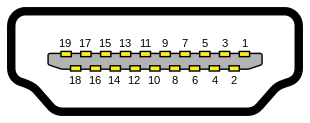| High-Definition Multimedia Interface | ||||
|---|---|---|---|---|
| ||||
| Type | Digital audio/video connector | |||
| Production history | ||||
| Designer | The HDMI group | |||
| Designed | December 2002 | |||
| Manufacturer | Various | |||
| Produced | 2003 | |||
| Specifications | ||||
| Hot pluggable | Yes | |||
| External | Yes | |||
| Audio signal | PCM, DVD-Audio, Super Audio CD, Dolby TrueHD, DTS-HD Master Audio | |||
| Video signal | 480i, 480p, 576i, 576p, 720p, 1080i, 1080p, 1440p, etc. | |||
| Bandwidth | 10.2 Gbit/s at 340 Mpixel/s | |||
| Pins | 19 | |||
| Pin out | ||||
 Type A (Female) HDMI | ||||
| Pin 1 | TMDS Data2+ | |||
| Pin 2 | TMDS Data2 Shield | |||
| Pin 3 | TMDS Data2– | |||
| Pin 4 | TMDS Data1+ | |||
| Pin 5 | TMDS Data1 Shield | |||
| Pin 6 | TMDS Data1– | |||
| Pin 7 | TMDS Data0+ | |||
| Pin 8 | TMDS Data0 Shield | |||
| Pin 9 | TMDS Data0– | |||
| Pin 10 | TMDS Clock+ | |||
| Pin 11 | TMDS Clock Shield | |||
| Pin 12 | TMDS Clock– | |||
| Pin 13 | CEC | |||
| Pin 14 | Reserved (N.C. on device) | |||
| Pin 15 | SCL | |||
| Pin 16 | SDA | |||
| Pin 17 | DDC/CEC Ground | |||
| Pin 18 | +5 V Power | |||
| Pin 19 | Hot Plug Detect | |||
The High-Definition Multimedia Interface (HDMI) is a licensable audio/video connector interface for transmitting uncompressed, encrypted digital streams. HDMI connects DRM-enforcing digital audio/video sources, such as a set-top box, a HD DVD Disc player, a Blu-ray Disc player, a Personal Computer, a video game console or an AV receiver, to a compatible digital audio device and/or video monitor such as a digital television (DTV). HDMI began to appear in 2006 on consumer HDTV camcorders and high-end digital still cameras.[1][2]
It represents the DRM alternative to consumer analog standards such as RF (coaxial cable), composite video, S-Video, SCART, component video and VGA, and digital standards such as DVI (DVI-D and DVI-I).
General notes
HDMI supports, on a single cable, any TV or PC video format, including standard, enhanced or high-definition video, plus multi-channel digital audio. It is independent of the various DTV standards such as ATSC, and DVB (-T,-S,-C), as these are encapsulations of the MPEG movie data streams, which are passed off to a decoder and output as uncompressed video data on HDMI. HDMI encodes the video data into TMDS for transmission digitally over HDMI.
Devices are manufactured to adhere to various versions of the specification, where each version is given a number, such as 1.0 or 1.3. Each subsequent version of the specification uses the same cables, but increases the throughput and/or capabilities of what can be transmitted over the cable. For example, previously, the maximum pixel clock rate of the interface was 165 MHz, sufficient for supporting 1080p at 60 Hz or WUXGA (1920x1200), but HDMI 1.3 increased that to 340 MHz, providing support for WQXGA (2560x1600) and beyond across a single digital link. See also: HDMI Versions.
HDMI also includes support for 8-channel uncompressed digital audio at 192 kHz sample rate with 24 bits/sample as well as any compressed stream such as Dolby Digital, or DTS. HDMI supports up to 8 channels of one-bit audio, such as that used on Super Audio CDs at rates up to 4x that used by Super Audio CD. With version 1.3, HDMI now also supports lossless compressed streams such as Dolby TrueHD and DTS-HD Master Audio.
HDMI is backward-compatible with the single-link Digital Visual Interface carrying digital video (DVI-D or DVI-I, but not DVI-A) used on modern computer monitors and graphics cards. This means that a DVI-D source can drive an HDMI monitor, or vice versa, by means of a suitable adapter or cable, but the audio and remote control features of HDMI will not be available. Additionally, without support for High-bandwidth Digital Content Protection (HDCP) on the display, the signal source may prevent the end user from viewing or recording certain restricted content.
PCs with hardware HDMI output may require software support from Operating Systems such as Windows Vista. Linux currently supports video output through backward-compatibility with DVI.
In the US, HDCP-support is a standard feature on digital TVs with built-in digital (ATSC) tuners. Among the PC-display industry, where computer displays rarely contain built-in tuners, HDCP support is absent from many models. For example, the first LCD monitors with HDMI connectors did not support HDCP, and few compact-LCD monitors (17" or smaller) support HDCP.
The HDMI Founders include consumer electronics manufacturers Hitachi, Matsushita Electric Industrial (Panasonic/National/Quasar), Philips, Sony, Thomson (RCA), Toshiba, and Silicon Image. Digital Content Protection, LLC (a subsidiary of Intel) is providing HDCP for HDMI. In addition, HDMI has the support of major motion picture producers Fox, Universal, Warner Bros., and Disney, and system operators DirecTV and EchoStar (Dish Network) as well as CableLabs and Samsung.
http://en.wikipedia.org/wiki/HDMI

No comments:
Post a Comment